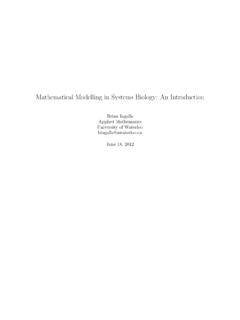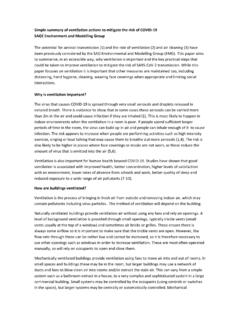Transcription of Headcount modelling | Optimisation tool
1 Headcount modelling Optimisation tool Consulting Headcount modelling | Optimisation tool Goals and objectives of Headcount modelling 3. As-is Headcount analysis 4. Increase in efficiency and Headcount Optimisation 6. Headcount demand forecasting 8. Headcount supply forecasting 10. Recruitment needs and personnel development forecasting 12. Additional options 13. Headcount modelling approach 14. About Deloitte 19. 02. Headcount modelling | Optimisation tool Goals and objectives of Headcount modelling What is Headcount modelling ? Headcount modelling is about creating and using an analytical tool (a Headcount model) to look at the current personnel structure and develop Headcount forecasting. Tasks The modelling process can be used as the basis for solutions to a number of important operational and strategic considerations for an entity: Consolidating Headcount data into an integrated database As-is Headcount analysis and analysing the current Headcount against the company's structure, functions, grades, age groups, etc.
2 Identifying and prioritising areas for Headcount Increase in efficiency and Optimisation through increased productivity, personnel Headcount Optimisation structure changes, etc. Headcount demand Target Headcount forecasting based on production forecasting programmes and strategic indicators. Identifying internal and external sources for the Headcount supply satisfaction of Headcount demand according to forecasting qualification and function. Recruitment needs and Analysing imbalances between current personnel supply personnel development and demand, and preparing hiring plans. forecasting Who is this relevant for? Leaders and specialists who use Headcount Entities and holdings with a well-developed network analysis to make management decisions: of assets, branches and business units: HR leaders and employees Entities engaged in mining and mineral resource processing. Leaders of business units and asset managers Large companies with high production capacities.
3 Leaders responsible for mid and long- Banks and other financial institutions with term planning a developed retail chain. Specialists responsible for the Retail networks etc. Optimisation of business processes etc What this brochure is about? This publication covers the approach used to develop Headcount models for companies in various industries handling a broad range of management tasks using Headcount modelling , including examples of the tasks completed and results achieved. 03. Headcount modelling | Optimisation tool As-is Headcount analysis The model provides insights into the following key questions: Consolidating Headcount data 01. What is the existing Headcount structure broken down by function, into an integrated database and organisational level, grade, analysing the current Headcount 02. What is the current personnel age structure? against the company's structure, functions, grades, age groups, etc.
4 03. What is the Headcount structure broken down by other specific categories used by the company? 04. What do the Headcount key performance indicators indicate? 1 Comparative as-is Headcount analysis broken down by various data sets The model allows the as-is Headcount to be visualised according to: Business unit and asset Function/process Qualification Clicking the chart reveals the Headcount details by category. A personnel imbalance for a function, qualification, etc. may be identified by using a combination of analytical breakdowns and comparing the assets and business units. 04. Headcount modelling | Optimisation tool 2 As-is Headcount analysis by age group The model allows the Headcount structure to be visualised by age group with additional data breakdowns: by grade, process, etc. Analysing the personnel age structure helps management identify the optimal approach towards internal processes (for example, communications), corporate programmes, etc.
5 3 Headcount analysis using specific filters The model allows any set of filters to be applied to current Headcount analysis: Local/seconded Open/closed vacancies Gender, age, etc. 4 Review of the entity's key performance indicators The model enables the user to see the company's key performance indicators on the same screen in a dashboard format. The dashboard format can be used for current Headcount analysis, target Headcount forecasting and efficiency enhancement. 05. Headcount modelling | Optimisation tool Increase in efficiency and Headcount Optimisation The model provides insights into the following key questions: Identifying and prioritising areas 01. What are the internal and external benchmarks for increased for Headcount Optimisation productivity and personnel structure? through increased productivity, 02. What is the potential for the Headcount Optimisation due to the productivity increase up to the level of the best practices?
6 Personnel structure changes, etc. 03. How to prioritise areas for the Headcount Optimisation ? 1 Internal and external benchmarking The model defines the maximum productivity for functions or processes according to the set of assets/business units. The model enables the Headcount structure to be analysed by various categories to identify any imbalance between the categories. The model enables external benchmarking by strategic and operating indicators. Reviewing the implementation of a process in an asset where the productivity is higher compared to other assets allows an entity to use its experience for similar processes in other assets to increase their productivity. 06. Headcount modelling | Optimisation tool 2 Determining the potential for Headcount Optimisation The model enables several scenarios to be established, which all include criteria for the statistical selection of productivity based on internal benchmarking results The model enables the as-is and target headcounts to be compared by: Company/asset Process/function Business unit, etc.
7 A factor analysis allows the entity to detail changes in processes, business units, etc. Aside from allowing increases in productivity to be assessed, the model enables the assessment of Headcount Optimisation through: Outsourcing functions Not implementing a number of projects, etc. 3 Prioritising areas for Headcount Optimisation The model enables sensitivity analysis to be carried Sensitivity analysis enables out, which is an assessment of the effect of changes the selection of the most in the model's parameters on the Headcount . important areas for efficiency improvement and prioritisation in terms of the development and The model allows the highest priority areas for implementation of Headcount Optimisation to be selected. initiatives. Prioritisation criteria include: Absolute and relative Headcount reduction Personnel cost reduction, etc. Highest priority initiatives 07.
8 Headcount modelling | Optimisation tool Headcount demand forecasting The model provides insights into the following key questions: Target Headcount forecasting 01. What is the Headcount required for various strategic scenarios? based on production programmes and strategic indicators. 02. What is the Headcount required for the implementation of the production programme? 03. What drivers impact the Headcount demand and how? 1 Headcount demand forecasting adjusted for changes in strategic indicators The model allows the company to forecast labour input drivers and calculate demand based on the entity's strategic indicator plan for several scenarios. The model allows management to assess the effect of implementing or not implementing a capital or efficiency improvement project on Headcount . 08. Headcount modelling | Optimisation tool 2 Headcount demand forecasting adjusted for the entity's production programme The model allows the specific features of the production process affecting the Headcount to be taken into account.
9 Decomposition reveals the main labour input areas. By adding cost data to the model, it becomes possible to identify processes or business units with the highest personnel The model allows for Headcount decomposition by: Process/function Business unit Equipment type, etc. The model makes it possible to calculate several scenarios for various production programmes and to compare the respective target headcounts. 10%. 3 Analysis of factors affecting changes in Headcount demand The model allows for the decomposition of Headcount change by labour input driver. 09. Headcount modelling | Optimisation tool Headcount supply forecasting The model provides insights into the following key questions: Identifying internal and external 01. How many current employees will the entity still have sources for the satisfaction of on staff in several years' time? Headcount demand according to 02.
10 How will changes in career growth programmes impact upon the entity's grade structure? qualification and function. 03. How many employees will be retiring, leaving, moving to other departments, etc. per annum? 04. What is the nature of the external Headcount supply from key higher education institutions, regions, countries and fields? 1 Identifying sources for the satisfaction of Headcount demand based on existing resources, including dismissal The model enables detailed personnel movement parameters to be set: Personnel turnover Retirement Vacancies filled using internal resources, etc. The model allows the entity to forecast internal Headcount supply according to: Personnel category Age group Qualification, etc. 10. Headcount modelling | Optimisation tool 2 Analysis of career growth depending on various development plans Fast promotions may result in rapid growth in the management Headcount .

















